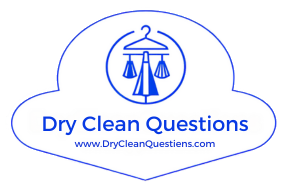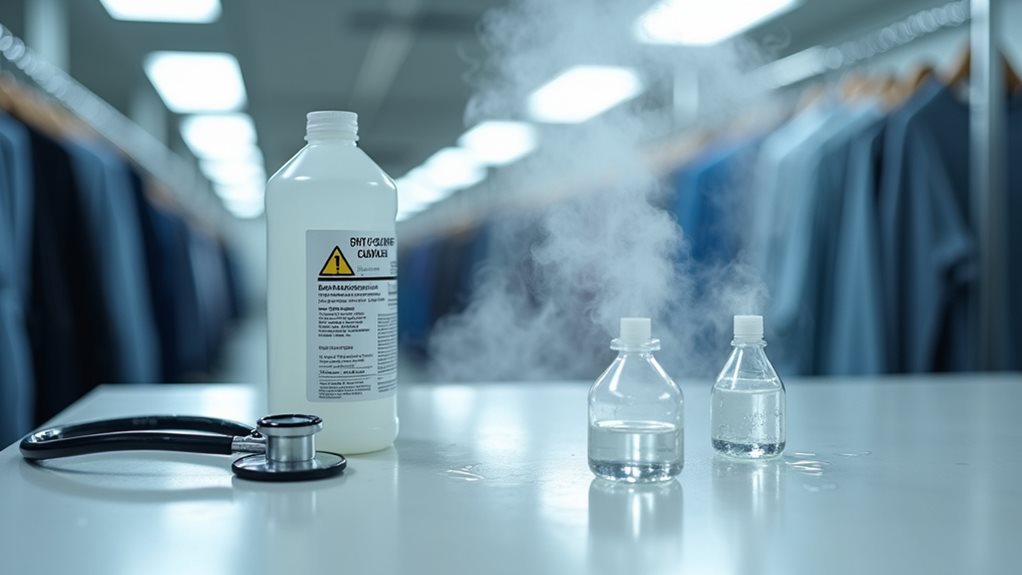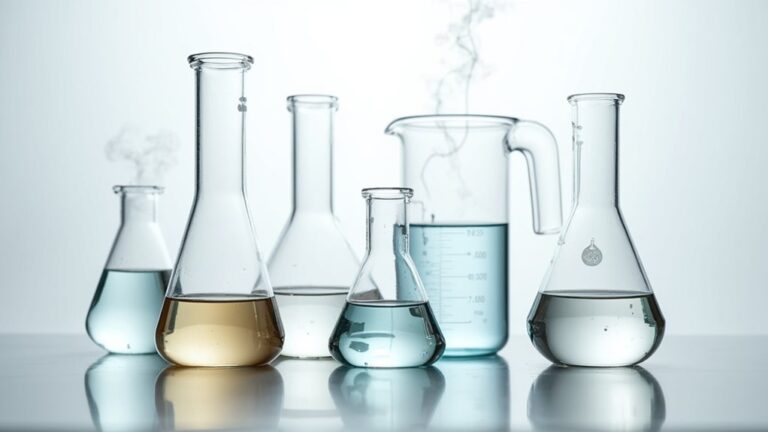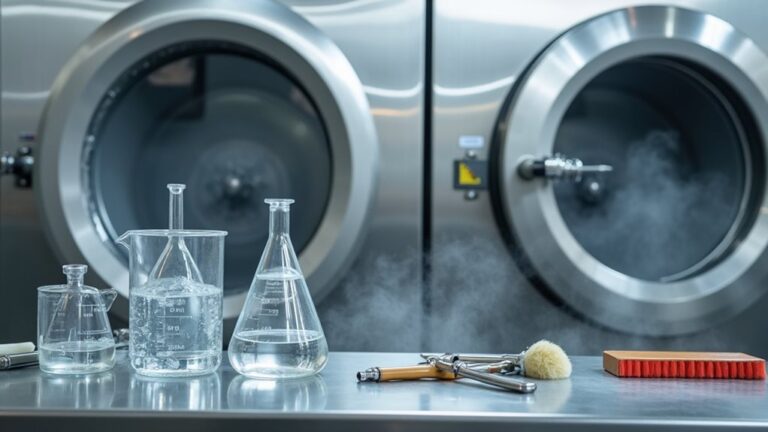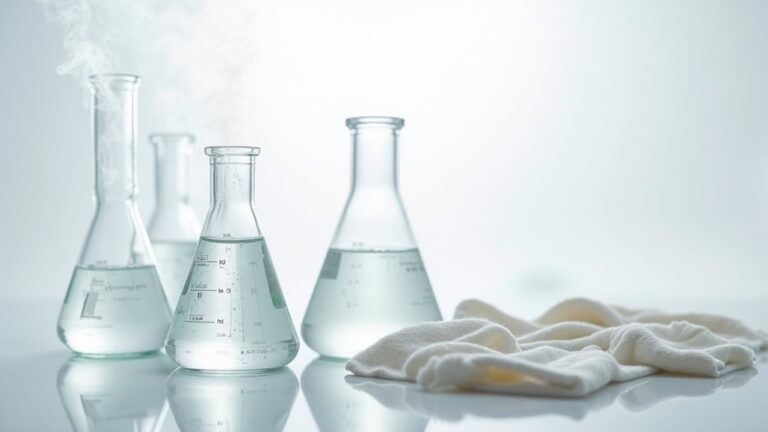Traditional dry cleaning can pose health risks due to perchloroethylene (PERC), a probable carcinogen that lingers on your clothes and contaminates indoor air. You’ll face potential exposure to chemicals linked to bladder cancer, non-Hodgkin lymphoma, and neurological issues, especially if you’re pregnant or have children at home. That distinct chemical smell signals vapors that can cause dizziness, headaches, and long-term health complications with repeated exposure – though safer alternatives exist for those who explore their options.
What Chemicals Are Used in Traditional Dry Cleaning?
When I first started dropping off my favorite blazer at the neighborhood dry cleaner, I never really thought about what mysterious chemicals were working behind those industrial machines, though perhaps I should have been more curious about the process that could magically erase wine stains and wrinkles alike.
Behind the neighborhood dry cleaner’s industrial hum lies a world of mysterious chemicals that can magically erase stains and wrinkles alike.
The dry cleaning industry primarily relies on perchloroethylene, better known as PERC, which dissolves oil-based stains effectively but carries considerable health risks. This solvent is classified as a probable carcinogen, and you’ll find it lingering on freshly cleaned clothes.
Many cleaners also use alternative solvents like n-propyl bromide, but these toxic chemicals present their own dangers, including reproductive harm and neurotoxic effects.
While eco-friendly alternatives exist, the environmental impact remains concerning. Fortunately, many modern dry cleaners now offer safer options such as wet cleaning, liquid CO2 cleaning, and eco-friendly solvents that reduce health risks.
Health Risks Associated With PERChloroethylene (PERC) Exposure
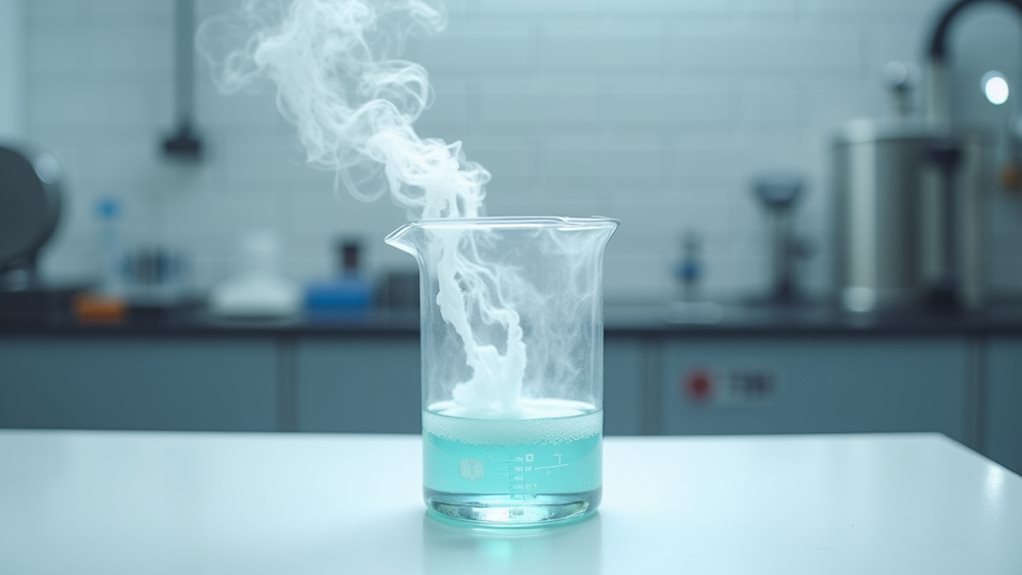
Although I’d naively assumed that fresh-from-the-cleaner smell meant my clothes were somehow “cleaner” and safer, I’ve since learned that PERC exposure poses serious health risks that extend far beyond that chemical scent clinging to your favorite dress shirt.
Perchloroethylene (PERC), the dominant solvent in traditional dry cleaning, is classified as a probable carcinogen linked to bladder cancer and non-Hodgkin lymphoma. Acute exposure triggers dizziness, headaches, and cognitive issues, while chronic contact compromises your reproductive and immune systems.
Workers face the highest risk, but you’re also affected since residual PERC vaporizes from treated garments, contaminating your indoor air.
PERC exposure has also been linked to neurological problems and liver damage, making it particularly concerning for vulnerable populations including pregnant women and children.
Thankfully, the Environmental Protection Agency is phasing out these toxic substances by 2034.
How PERC Affects Dry Cleaning Workers and Surrounding Communities
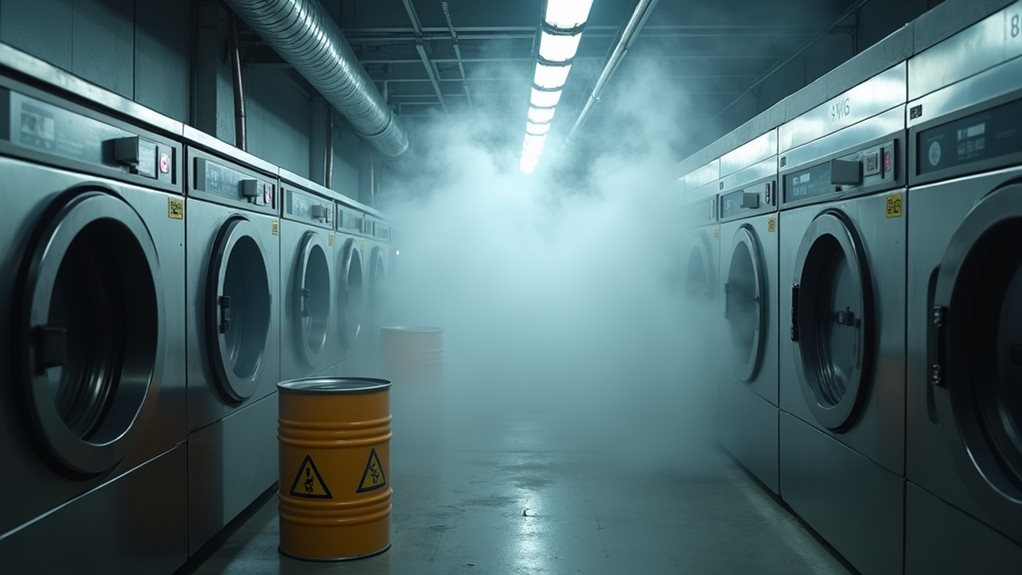
While you and I might worry about the occasional whiff of PERC from our dry-cleaned blazers, the people who work inside these facilities face a completely different level of exposure that frankly kept me awake after I started researching this topic. 😟
Dry cleaning workers spend eight-hour shifts breathing in PERC vapors, especially in older shops with poor ventilation systems, which means they’re constantly battling headaches, dizziness, and that foggy feeling that comes from chemical exposure.
What’s even more sobering is that long-term health risks for these workers include serious conditions like non-Hodgkin lymphoma and bladder cancer.
Beyond cancer risks, prolonged exposure to these carcinogenic vapors can also lead to neurological problems and liver damage in workers who handle contaminated materials daily.
Environmental contamination doesn’t stop at workplace doors either—local communities face groundwater pollution and air quality issues, making safer alternatives absolutely essential for protecting everyone’s health.
Chemical Residue That Remains on Your Clothing After Dry Cleaning

Even after your blazer returns from the dry cleaner looking crisp and professional, it’s carrying an invisible passenger that honestly made me rethink my entire relationship with “dry clean only” labels. 😅
The PERC used during cleaning doesn’t just magically disappear once the process ends—instead, it clings to fabric fibers like an unwelcome houseguest, slowly releasing vapors into your closet, your car, and yes, directly against your skin throughout the day.
This chemical residue isn’t just mildly concerning—perchloroethylene is classified as a probable carcinogen, which means your dry-cleaned fabrics could pose legitimate health risks every time you wear them.
Cotton and polyester hold onto these cleaning chemicals particularly stubbornly, while silk thankfully shows minimal retention, creating ongoing exposure that accumulates with multiple cleanings.
Fortunately, the strongest chemical odors typically dissipate within hours when garments receive proper ventilation, though some residue may persist longer depending on the fabric type.
Environmental Impact of Dry Cleaning Solvents on Air and Water
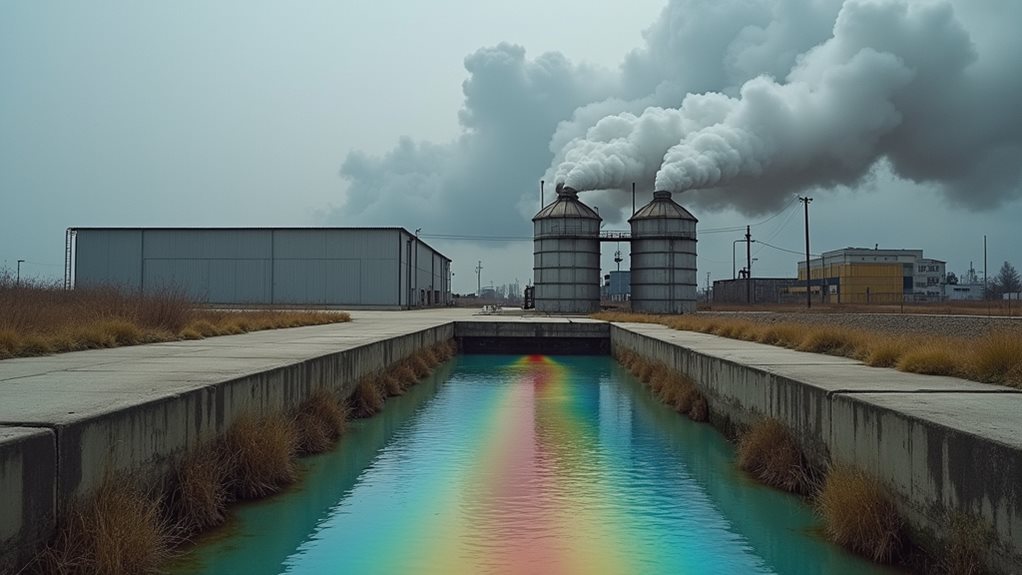
When I started researching where those dry cleaning chemicals actually go after they’ve finished “cleaning” our clothes, I discovered a sobering reality that extends far beyond our personal wardrobes and into the very air we breathe and water we drink. 😰
The same PERC that lingers on your freshly cleaned garments doesn’t stay contained within the dry cleaning facility—it escapes through ventilation systems, seeps into groundwater supplies, and persists in our outdoor environment for weeks at a time, creating a contamination cycle that affects entire communities.
These toxic chemicals contaminate the soil where your food grows, compromise air quality in neighborhoods surrounding dry cleaners, and even contribute to ozone layer depletion.
What’s particularly troubling is how long ecosystems take to recover from this environmental damage.
Fortunately, many facilities are now switching to safer alternatives like hydrocarbon solvents, liquid CO2, and wet cleaning methods to reduce these environmental impacts.
Safer Alternatives to Traditional Dry Cleaning Methods
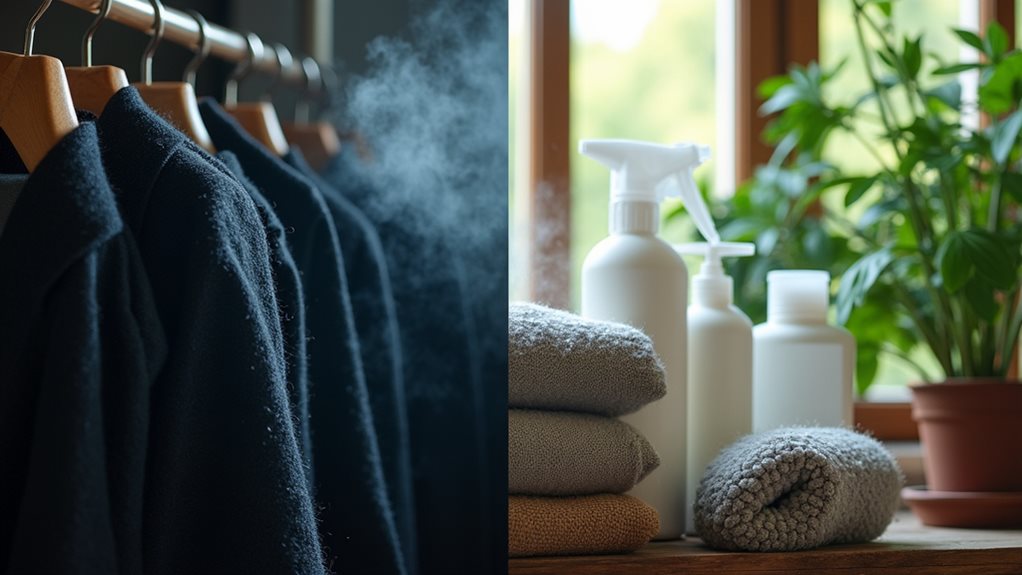
Given the concerning environmental and health impacts we’ve just explored, I’m relieved to tell you that breaking free from traditional dry cleaning doesn’t mean sacrificing the care your favorite clothes deserve. 🌿
After years of assuming that “dry clean only” label was basically a commandment carved in stone, I discovered there’s actually a whole world of gentler, safer alternatives that can keep your wardrobe looking pristine without exposing you, your family, or the planet to those harsh PERC chemicals.
Breaking free from that “dry clean only” commandment opened up a world of gentler alternatives for my wardrobe.
Here are three game-changing eco-friendly alternatives I’ve personally tested:
- Wet cleaning services use special soaps and technologies instead of toxic solvents
- At-Home Dry Cleaner kits like Dryel refresh clothes without harsh chemicals
- Steamers effectively remove odors and light stains using only water
You can also seek out organic dry cleaners using non-toxic solvents like liquid silicone.
For delicate fabrics that seem impossible to clean at home, try gentle hand-washing with mild detergents followed by proper air-drying techniques.
When Professional Dry Cleaning Is Actually Necessary

While we’ve explored safer dry cleaning options, I’ll be honest with you – there are times when you simply can’t avoid professional cleaning, and I learned this the hard way when I tried washing my beaded wedding dress at home (spoiler alert: it didn’t end well 😅).
Your embellished garments, those gorgeous structured blazers that make you feel like a boss, and delicate fabrics with “dry clean only” labels aren’t just being high-maintenance – they genuinely need specialized care to survive.
Materials like silk, wool, and cashmere can shrink or lose their shape when exposed to the water and agitation of regular washing machines, which is why chemical solvents are necessary to clean these items safely.
The good news is that you can now choose eco-friendly dry cleaners that use safer chemical alternatives, which means you’re protecting both your favorite clothes and your health at the same time.
Embellished Garment Care
Although I’ve learned the hard way that not every garment needs professional cleaning, some pieces genuinely can’t survive your home washing machine, and it breaks my heart to see someone ruin a stunning beaded dress because they thought they could save a few bucks.
Embellished garments with glued sequins, beads, or intricate designs need professional dry cleaning because water weakens the adhesive holding those beautiful details together. I’ve watched friends lose half their dress’s sparkle after one wash cycle! 🥲
Here’s when you absolutely need professional care:
- Silk garments with glued embellishments or delicate fabric construction
- Heavily beaded or sequined pieces where decorations might fall off
- Intricate designs that could snag or tear in washing machines
Professional dry cleaning uses chemical solvents instead of water to safely remove stains and dirt while preserving both the fabric integrity and delicate embellishments that make your garments special.
Consider eco-friendly cleaning methods to reduce health and environmental risks from traditional dry cleaning chemicals, especially with long-term exposure concerns.
Structured Fabric Requirements
When I see someone stuffing their wool blazer into a washing machine, I want to shout “Stop!” because certain fabrics literally can’t handle the tumbling, spinning chaos that our home machines create.
Your structured garments—those crisp blazers, custom suits, and lined dresses—depend on professional dry cleaning services to maintain their sophisticated shape and polished appearance.
These fabrics possess an architectural quality that home washing destroys faster than you can say “wardrobe malfunction” 😅. The delicate nature of these materials, combined with their intricate construction, makes cleaners your best friend for preserving that investment-worthy look.
Plus, when oil-based stains inevitably happen (because life), dry-clean-only clothing requires specialized solvents that your trusty detergent simply can’t match.
Items with intricate details like beading, sequins, or pleating also need professional treatment since these decorative elements can be damaged or distorted by conventional washing methods.
Safer Chemical Alternatives
Because I’ve learned the hard way that not all dry cleaning chemicals are created equal, I want you to know about the safer chemical alternatives that exist for those times when professional cleaning truly becomes unavoidable.
The risks of PERC, the traditional solvent, include headaches and potential long-term health issues, but thankfully, environmentally friendly dry cleaners now offer better options.
When you absolutely need professional care, look for these safer chemical alternatives:
- Professional wet cleaning uses specialized soaps and gentle processes without toxic chemicals
- Liquid carbon dioxide cleaning employs pressurized CO₂ instead of harsh solvents
- Silicone-based solvents provide effective cleaning with reduced environmental impact
Modern dry cleaning facilities are heavily regulated and use advanced equipment with safety protocols to minimize health and environmental risks.
Don’t hesitate to ask your local cleaner about eco-friendly cleaning options – you’re helping drive industry change while protecting your health!
How to Minimize Your Exposure to Harmful Dry Cleaning Chemicals
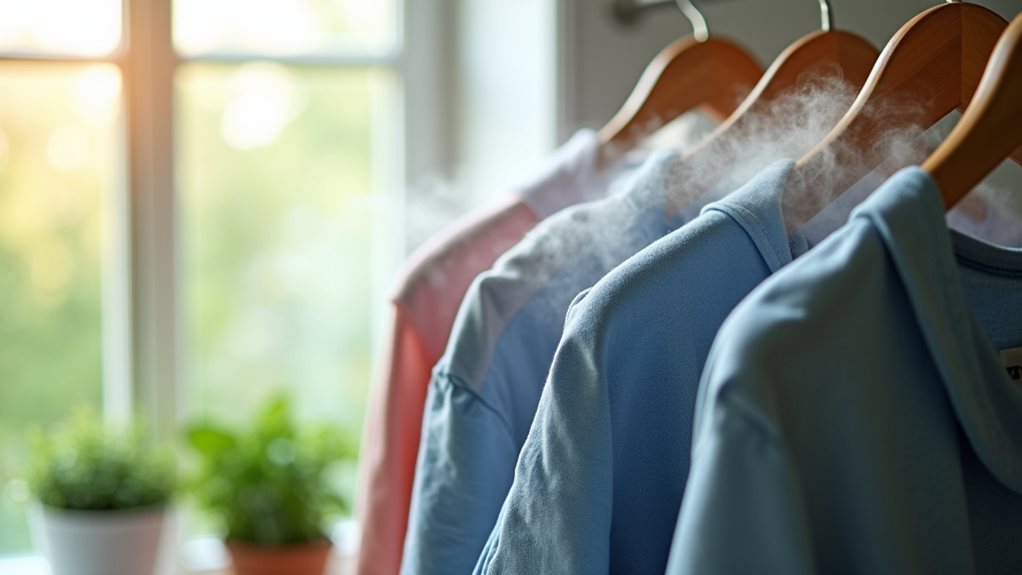
While you can’t completely eliminate your exposure to dry cleaning chemicals, you can definitely take some smart steps to protect yourself and your family from unnecessary harm. Since many dry cleaners use perchloroethylene and other toxic chemicals, I’ve learned to be strategic about my choices.
First, seek out eco-friendly dry cleaning services that offer non-toxic solvents like liquid silicone—trust me, they’re worth the extra search effort. Always air out dry-cleaned clothes outdoors for several hours before bringing them inside; it’s like giving your garments a detox session 🌬️.
Ask your cleaner about their cleaning processes, store items in well-ventilated areas, and consider investing in a VOC-rated air purifier to minimize exposure throughout your home.
